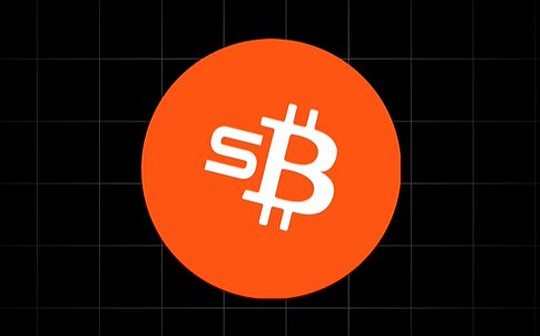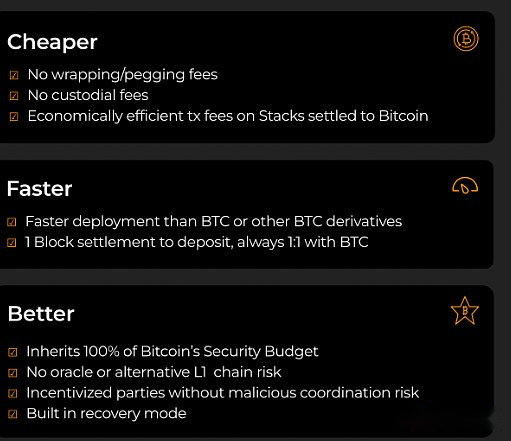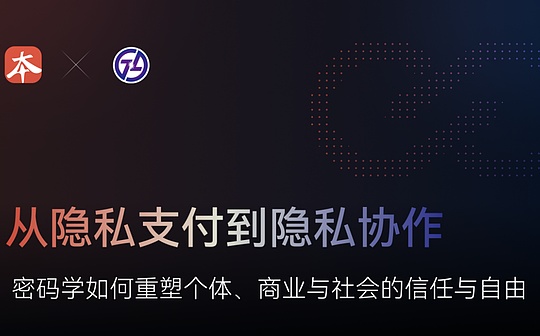
Source: Stacks
At 0:00 on December 18, 2024, sBTC officially launched the BTC L2 Stacks main network.

Stacks is the leading Bitcoin L2, the sBTC main network is launched, introducing US$2 trillion in BTC liquidity into the on-chain ecosystem channel, and is expected to completely activate BTCFi.
Introduction to sBTC
What is sBTC?
sBTC is an asset anchored to Bitcoin on the second-layer Bitcoin network Stacks. It will enable developers to create fruitful application scenarios for Bitcoin, for Bitcoin decentralized finance (DeFi),Fields such as non-fungible tokens (NFTs) have opened the door.
Unlocking Bitcoin liquidity is a key narrative, especially considering that Ethereum has a much higher total locked value (TVL) in its DeFi ecosystem, despite its market capitalization of less than 25% of Bitcoin.
sBTC aims to unlock over $2 trillion in Bitcoin liquidity through Stacks for use by DeFi and decentralized applications (dApps), paving the way for a thriving Bitcoin-driven economy.
sBTC is operated by numerous signers, including institutional giants such as BitGo, Asymmetric, Ankr, etc., making it the most decentralized layer 2 network BTC.In addition, transactions on the L2 network are guaranteed by a 100% Bitcoin security budget, making Bitcoin transactions on the L2 network as irreversible as they are on the L1 network.
How does sBTC work?
The user operation process begins with Bitcoin main network transactions, where BTC is deposited into a multi-signature protocol monitored by a decentralized Stacks signer group.
Once BTC is deposited, sBTC is cast on Stacks, enabling users to interact with DeFi decentralized applications.
Thanks to this design, users can even participate in Bitcoin DeFi without even knowingly on Stacks.For example, the Zest protocol will support Bitcoin mainnet deposits and will automatically convert to sBTC.As sBTC may become a fee Gas token on Stacks in the future, the user experience will be further improved.

Will sBTC have an upper limit?
At this stage, a deposit cap of 1,000 BTC will be implemented for controllable testing.As continued security measures continue to strengthen the agreement, the scale will expand.
In the early stages, only the deposit feature will be enabled and the withdrawal feature will be temporarily unavailable.
Will sBTC benefit?
Imagine that you can earn Bitcoin earnings by simply holding BTC.No staking, no points, no complexity – just get the Bitcoin rewards into your wallet.Early users of sBTC were connecting wallets tohttps://bitcoinismore.org/(Online at 11 a.m. ET on December 17, 00:00 Beijing time on December 18), you will receive an annualized rate of return (APY) of 5%.
This is now possible through the sBTC Rewards Program.Early users can receive Bitcoin rewards as long as they hold sBTC – distributed in the form of sBTC.
The sBTC rewards program is powered by a group of participants in “Stacking” STX (Native Tokens of Stacks).
When STX Stacking is performed, participants obtain Bitcoin through Stacks’ consensus mechanism.To enable the sBTC reward program, these participants contributed the corresponding Proof of Transfer Bitcoin rewards to the sBTC reward pool.
BTC from the reward pool is deposited directly into a smart contract that converts Bitcoin to sBTC and allocates the reward proportionally to sBTC holders.The protocol takes snapshots of sBTC held by users every day, and the reward is allocated once every two weeks (i.e. the duration of a PoX cycle).
The estimated Bitcoin reward is currently 5% annualized and is distributed every two weeks.

Key features of sBTC?

DeFi use cases for sBTC: Additional benefits
Where can sBTC be used?
Multiple DeFi protocols will support sBTC, allowing users to gain more than 5% extra benefits by simply holding sBTC:
1.Bitflow DEX:
Liquidity pool: Users can deposit sBTC into Bitflow’s liquidity pool to facilitate transactions and earn transaction fee sharing.
Yield Farming: Liquidity providers can pledge their LP tokens in a Earnings Farming program to earn additional rewards, which are usually derived from trading activities or platform incentives.
Early deployment of sBTC is expected to receive an additional annualized rate of return of 10 – 30%.
Bitflow Runes AMM:
Bitflow has launched a Stacks Layer 2 network rune automatic market maker, where you can bring runes to Layer 2 network for a better user experience.
sBTC will be included in the Zest Agreement lending market on day one.
The Zest protocol will start a yield-enhancing activity on its lending market from day one, providing up to 10% bitcoin yields to the sBTC supply.
Zest will also unlock more DeFi strategies involving sBTC, such as:
-
Deposit sBTC to get up to 10% of Bitcoin annualized yield
-
Borrow USDh stablecoins with Bitcoin (or other stablecoins and exchange them for USDH)
-
Pledge USDh inHermeticaThe annualized yield of stablecoins can be obtained up to 25%, and USDh is a yield-based stablecoin supported by Bitcoin with a yield of 25%.
Reminder: Hermetica’s DeFi protocol offers USDh, the first profitable stablecoin backed by Bitcoin.Its income is generated sustainably through the payment of perpetual contract funding rates on centralized exchanges and is distributed on a daily basis.
stSTXbtc is a new liquid staked token that users can use in Stacks’ DeFi.By holding the token, users will receive up to 10% of the pledge rewards paid in sBTC directly in their wallet.
Liquidity provision: Users can supply sBTC to Velar’s liquidity pool, facilitate transactions and earn transaction fee sharing generated by the platform.
Earning Farming: By participating in the Earning Farming Program, users can stake LP tokens obtained for providing sBTC liquidity to earn additional rewards in Velar native tokens or other forms of incentives.
Staking: If Velar launches sBTC’s staking option, users can lock their sBTC into the staking contract and earn rewards by supporting network operations, such as additional tokens or a percentage of revenue.
Velar will have its own incentive plan that allows you to deploy sBTC in a pool of its decentralized exchange to earn native tokens called VELAR.
By governing the vote, Arkadiko will allow sBTC to act as collateral within its agreement, enabling users to borrow USDA or other assets with the Bitcoin they hold.
Users can deposit sBTC into ALEX’s liquidity pool and pair it with another asset, such as STX or stablecoin.Doing so can facilitate transactions on the platform and earn transaction fees generated by the pool.
ALEX will provide additional benefits through Surge Campaign in the form of its native token, ALEX.This means that in addition to the 5% annualized rate of return on the sBTC rewards program, you can earn income by joining the sBTC pool, as well as earn additional ALEX token rewards.
6.Granite (not yet online) – Lending Agreement
Borrowers can obtain stablecoin loans by staking their bitcoins, while liquidity providers earn money by providing stablecoins to the protocol.
Borrowing: Users can borrow sBTC as collateral to stablecoins, which can then be used in various DeFi strategies to earn profits.
Liquidation participation: Users can act as liquidator to repay some loans that are under-collateralized in exchange for collateral and rewards, thereby earning profits through the liquidation process.
Granite currently has oneWaiting list, people who register in advance are allowed to use it in advance.Ultimately, a points system will bring additional benefits, and users who register early will gain significant advantages.
How is sBTC different from other Bitcoin assets (such as wBTC, cbBTC, ecc, etc.)?
These bitcoin assets usually require sending bitcoin to an intermediary, or rely on a trusted alliance of signers or small multi-signature mechanisms.
sBTC will initially rely on 15 signers, including enterprise-level organizations such as BlockDaemon, Figment, Luganodes, and Kiln, to handle peg-ins and peg-outs operations.Over time, this responsibility will be passed on to all Stacks signers, allowing anyone to participate in keeping the network secure and decentralizing it.BitGo, Aptos Foundation, etc. are expected to join the action.
In addition, thanks to Stacks’ design, sBTC will benefit from 100% of Bitcoin finality, which means that transactions on the Stacks layer will be as irreversible as Bitcoin transactions.
Reminder: The signer is responsible for verifying and approving each block generated; as long as enough STX accumulates to become an independent signer, anyone can become a signer—a similar to the concept of a verifier.
sBTC Supplementary Information
1) Other information about sBTC:
-
sBTC website:https://www.stacks.co/sbtc
-
sBTC Documentation:https://docs.stacks.co/concepts/sbtc
-
sBTC presentation:https://www.stacks.co/sbtc-deck
2) Satoshi Nakamoto upgrade information:
-
Satoshi Nakamoto upgrade website:https://www.nakamoto.run/
-
document:https://docs.stacks.co/nakamoto-upgrade/nakamoto-upgrade-start-here
Satoshi Nakamoto’s upgrade is crucial because it brings the following results:
-
Quick block production (currently shortened from 10 minutes to less than 1 minute after optimization)
-
100% Bitcoin Finality
Quick block output:Quick block production brings a Solana-like experience to transactions and Bitcoin DeFi interactions, greatly improving the overall user experience of interacting with Stacks Layer 2 networks.
Stacks’ DeFi ecosystem is developing rapidly this year, and it only takes a few seconds to apply DeFi strategies to facilitate new users to join and retain.
Before Satoshi Nakamoto hard fork, the Stacks block settled synchronously with the Bitcoin block (10 minutes on average), which made the chain slow and insufficient for DeFi activity.This limitation no longer exists.Instead, Stacks blocks can now be generated in just a few seconds and their performance is still improving.At the same time, Bitcoin’s security can still be utilized after the Bitcoin block is settled.
100% Bitcoin Finality:Through Satoshi Nakamoto’s upgrade, transactions occurring on the Stacks Layer 2 network can utilize 100% of the Bitcoin security budget, which means that once subsequent Bitcoin blocks are settled, Stacks transactions will become as irreversible as Bitcoin transactions.
Instead of a single Stacks block bound to a single Bitcoin block, the Bitcoin block is now bound to the miner’s tenure, during which they can mine multiple Stacks blocks that can settle in seconds.
There are currently 50 signers, including enterprise-level organizations such as BitGo, Aptos, Luganodes, Kiln, etc., responsible for verifying and approving each block generated during the miner’s tenure.
Quick block time plus Bitcoin finality makes Stacks the safest and scalable Bitcoin Layer 2 network running through a decentralized signature network, which will allow Bitcoin to be realized in the future through the upcoming sBTC upgradeTransfer to the decentralized transition to the second-tier network.
3) Stacks analysis platform:
-
Signal 21:https://signal21.io/
-
DefiLlama:https://defilama.com/chain/Stacks
-Stacks browser:https://explorer.hiro.so/








